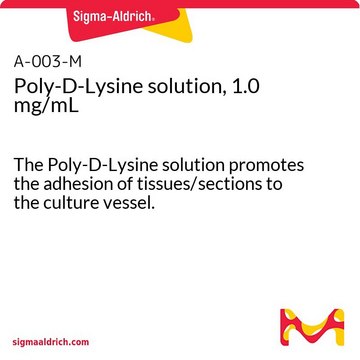P7405
Poly-ᴅ-Lysine Hydrobromide
synthetic, mol wt >300,000, powder, γ-irradiated, suitable for cell culture, BioXtra
Sinónimos:
PDL
About This Item
Productos recomendados
Nombre del producto
Poli-D-lisina hydrobromide, mol wt >300,000, lyophilized powder, γ-irradiated, BioReagent, suitable for cell culture
origen biológico
synthetic (chemical)
Nivel de calidad
esterilidad
γ-irradiated
Línea del producto
BioReagent
BioXtra
Formulario
lyophilized powder
mol peso
>300,000
envase
pkg of 5 mg
concentración
0.016—0.032 mmol lysine
técnicas
cell culture | mammalian: suitable
cobertura de la superficie
4 μg/cm2
solubilidad
H2O: soluble 50 mg/mL, clear, colorless
Condiciones de envío
ambient
temp. de almacenamiento
−20°C
cadena SMILES
O=C(C)[C@@](NC)([H])CCCCN.[Br]
InChI
1S/C6H14N2O2.BrH/c7-4-2-1-3-5(8)6(9)10;/h5H,1-4,7-8H2,(H,9,10);1H
Clave InChI
MEXAGTSTSPYCEP-UHFFFAOYSA-N
¿Está buscando productos similares? Visita Guía de comparación de productos
Descripción general
Aplicación
- in preparing the surface of coverslips for cell attachment
- in coating glass-bottom dishes for live cell imaging of primary cortical neuronal cells
- in coating 24-well plates for the isolation of primary astrocytes to study the impact of melanoma-derived exosomes on the reprogramming of stromal cells within the metastatic microenvironment
- for coating 16-well chamber slides to study the effects of maternal immune activation on behavioral impairments and alterations in cytokine and synaptic protein expression in the cerebellum
Este producto está recomendado como sustrato de cultivo celular cuando se utilizan entre 0,5 y 1,0 ml de una disolución 0,1 mg/ml para recubrir 25 cm2. Las versiones del producto de menor peso molecular son menos viscosas, pero las versiones de gran peso molecular proporcionan mas sitios de fijación por molécula.
Acciones bioquímicas o fisiológicas
Componentes
Precaución
Nota de análisis
Código de clase de almacenamiento
11 - Combustible Solids
Clase de riesgo para el agua (WGK)
WGK 3
Punto de inflamabilidad (°F)
Not applicable
Punto de inflamabilidad (°C)
Not applicable
Equipo de protección personal
Eyeshields, Gloves, type N95 (US)
Elija entre una de las versiones más recientes:
¿Ya tiene este producto?
Encuentre la documentación para los productos que ha comprado recientemente en la Biblioteca de documentos.
Los clientes también vieron
Artículos
Poly-Lysine enhances electrostatic interaction between negatively-charged ions of the cell membrane and positively-charged surface ions of attachment factors on the culture surface. When adsorbed to the culture surface, it increases the number of positively-charged sites available for cell binding.
Extracellular matrix proteins such as laminin, collagen, and fibronectin can be used as cell attachment substrates in cell culture.
Protocolos
Poly-L-Lysine Cell Attachment Protocol
Nuestro equipo de científicos tiene experiencia en todas las áreas de investigación: Ciencias de la vida, Ciencia de los materiales, Síntesis química, Cromatografía, Analítica y muchas otras.
Póngase en contacto con el Servicio técnico






